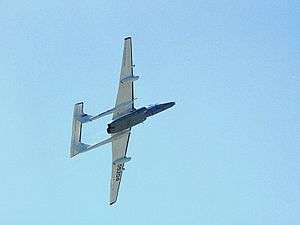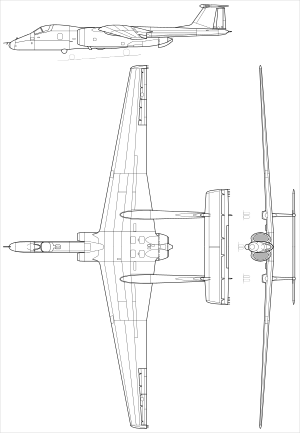Myasishchev M-55
| M-55 Geophysica | |
|---|---|
 | |
| Myasishchev M-55 Geophysica at MAKS Airshow 2001 | |
| Role | High-altitude reconnaissance |
| Manufacturer | Myasishchev |
| First flight | Subject 34: December 1978,[1] M-17: 26 May 1982, M-55: 16 Aug 1988 |
| Status | In service |
| Primary user | flown with Aeroflot titles |
| Number built | Subject 34: 1,[1] M-17: at least 2, M-55: 5 |
|
| |
The Myasishchev M-55 (NATO reporting name: Mystic-B) is a high-altitude geophysical research aircraft developed by OKB Myasishchev in the Soviet Union, similar in mission to the Lockheed ER-2, but with a twin boom fuselage and tail surface design. It is a twin-engined development of the Myasishchev M-17 Stratosphera with a higher maximum take-off weight.
Design and development
During the 1950s and 1960s the United States instituted several programs using high-altitude reconnaissance balloons, released over friendly territory to ascend into the jetstream and be transported over the Soviet Union and People's Republic of China.[2]
Subject 34
To combat these high-altitude balloons, Myasishchev proposed Subject 34 a single-seat turbojet-powered twin-boom high-aspect-ratio aircraft, nicknamed Chaika ("Seagull" in Russian) due to its anhedral wing design.[3] Armament of the single-seat balloon interceptor was to have been two air-air missiles (AAM) and two GSh-23 cannon with 600rpg in a dorsal turret. Before Subject 34 could be developed into operational hardware, the threat receded due to the success of the Keyhole reconnaissance satellites of the Corona program and the emergence of the Lockheed A-12.
The first prototype of Subject 34 was completed in secret at the Kumertau helicopter plant in Bashkirya, but whilst carrying out taxi tests, in December 1978 piloted by K. V. Chernobrovkinand, the prototype Chaika lifted off to avoid hitting snow banks and was destroyed after hitting a hillside in zero visibility.[1]
M-17 Stratosphera
The design of the Chaika was adapted as a reconnaissance aircraft and emerged as the Myasishchev M-17 Stratosphera with a revised airframe, including straight tapered wings with 2° 30' anhedral (0° at 1g), shorter fuselage pod and unreheated Kolesov RD-36-51 turbojet engine. Flown for the first time on 26 May 1982, the M-17 prototype (regn CCCP 17401) was soon allocated the NATO reporting name Mystic-A[2] and was used for investigating the Ozone layer over Antarctica in 1992.
The M-17 also set a total of 12 FAI world records, 5 of which still stand.[4] On 28 March 1990, M-17 CCCP 17401 piloted by Vladimir V. Arkhipenko[5] set an altitude record of 21,830 m (71,620 ft) in class C-1i (Landplanes: take-off weight 16 000 to 20 000 kg).[6]
M-55 Geophysica
The M-17 balloon-interceptor-based model was terminated in 1987 and replaced by the M-17RN, later known as the M-55 Geophysica, which was dubbed by NATO Mystic-B.[2] First flown on 16 Aug 1988, the M-55 airframe was revised further with a longer fuselage pod, housing two Soloviev D-30-10V un-reheated turbofan engines, shorter-span wings and comprehensive sensor payload.
The M-55 set a total of 15 FAI world records, all of which still stand today:[7] On 21 September 1993, an M-55 piloted by Victor Vasenkov from the 8th State R&D Institute of the Air Force named after V. P. Chkalov at Akhtubinsk reached a class record altitude of 21,360 m (70,080 ft) in class C-1j (Landplanes: take-off weight 20,000 to 25,000 kilograms (44,000 to 55,000 lb)).[8]
A dual-control version, the M-55UTS, was developed by adding a second cockpit behind the original, displacing some avionics and/or sensor payload.[1]
A number of M-55 Geophysica remain in service, performing in research roles; one M-55 took part in a study of the Arctic stratosphere in 1996–1997,[2] with similar experiments performed in Antarctica during 1999.[9]
An Irish-headquartered company Qucomhaps, with a focus on South East Asia, has entered a 1-billion USD deal to use the M-55 as a high-altitude platform station for digital communications.[10]
Variants
- Subject 34
- The prototype of a high-altitude balloon interceptor, dubbed Chaika (Gull), was completed in secret at the Kumertau helicopter plant in Bashkirya.[1]
- M-17 Stratosphera
- A reconnaissance version of Subject 34, given the NATO reporting name Mystic-A, powered by a single Kolesov RD-36-51 turbojet engine. At least two M-17 aircraft were built.[1]
- M-17RN
- Initial designation of what was to become the M-55.
- M-55 Geophysica
- A refined version of the M-17 powered by two Soloviev D-30-10V unreheated turbofans, carrying a wide variety of sensors for Earth-sciences research. Five M-55 aircraft were built, including one M-55UTS.
- M-55UTS
- A dual-control trainer version of the M-55 with a second cockpit directly aft of the forward cockpit, displacing some of the avionic/sensor payload, otherwise identical to the M-55.
- Geophysica 2
- a more advanced Earth-sciences research aircraft derived from the M-55, but not proceeded with.[1]
Operators
Specifications (M-55)


Data from The Osprey Encyclopedia of Russian Aircraft 1875–1995[1][11][12]
General characteristics
- Crew: 1 (M-55UTS: 2)
- Length: 22.867 m (75 ft 0 in)
- M-17 22.27 m (73.1 ft)
- Wingspan: 37.46 m (122 ft 11 in)
- M-17 40.32 m (132.3 ft)
- Height: 4.8 m (15 ft 9 in)
- Wing area: 131.6 m2 (1,417 sq ft)
- M-17 137.7 m2 (1,482 sq ft)
- Aspect ratio: M-55:10.6
- M-17: 11.9
- Airfoil: M-17: P-173-9
- Empty weight: 13,995 kg (30,854 lb)
- M-17 11,900 kg (26,200 lb)
- Gross weight: 23,400 kg (51,588 lb)
- M-17 18,400 kg (40,600 lb)
- Max takeoff weight: 23,800 kg (52,470 lb)
- M-17 19,950 kg (43,980 lb)
- Fuel capacity: T-8V aviation jet fuel 7,900 kg (17,400 lb) initially, 8,300 kg (18,300 lb) later
- Powerplant: 2 × Soloviev D-30-V12 low-bypass turbofan, 93.192 kN (20,950 lbf) thrust each
- M-17: 1 × 117.2 kN (26,300 lbf) Kolesov RD-36-51
Performance
- Never exceed speed: 332 km/h (206 mph; 179 kn) at 5,000 m (16,000 ft) (M-17 and M-55)
- 743 km/h (462 mph; 401 kn) at 20,000 m (66,000 ft) (M-17)
- 750 km/h (470 mph; 400 kn) at 20,000 m (66,000 ft) (M-55)
- Range: 4,965 km (3,085 mi; 2,681 nmi)
- Endurance: 6.5 hours at 17,000 m (56,000 ft)
- M-17: 2.25 hours
- Service ceiling: 21,500 m (70,538 ft)
- M-17: 21,500 m (70,500 ft)
- Maximum glide ratio: around 30:1 (engine off)
- Time to altitude: 21,000 m (69,000 ft) in 35 minutes
- Take-off distance: 900 m (3,000 ft)
- Landing distance: 780 m (2,560 ft)
See also
- Related development
- Aircraft of comparable role, configuration and era
References
- 1 2 3 4 5 6 7 8 Gordon, Yefim; Bill Gunston OBE FRAeS (2000). Soviet X-planes. Leicester: Midland Publishing. pp. 136–139. ISBN 1 85780 099 0.
- 1 2 3 4 Taylor, Michael J. H. Brassey's World Aircraft & Systems Directory 1999–2000, 2000. ISBN 1-85753-245-7, p. 157.
- ↑ Editors (2015-09-21), Russia's Last Soviet Spy Plane Still Flying High, Sputnik International, retrieved 2015-11-01
- ↑ "List of records established by the 'Myasishchev M-17'". Fédération Aéronautique Internationale. Retrieved 2008-06-19.
- ↑ Thornborough, Anthony M. (1991). Spy Planes and Other Reconnaissance Aircraft. London, UK: Arms and Armour Press. p. 7. ISBN 1-85409-096-8.
- ↑ "Powered Aeroplanes World Records#id2243". Geneva: Federation Aeronautique Internationale. Retrieved 25 July 2013.
- ↑ "Powered Aeroplanes World Records". Fédération Aéronautique Internationale. Retrieved 2015-03-07.
- ↑ "Powered Aeroplanes World Records#id814". Geneva: Federation Aeronautique Internationale. Retrieved 25 July 2013.
- ↑ Airborne Polar Experiment – Geophysics Aircraft In Antarctica (APE-GAIA).
- ↑ "Qucomhaps Press Release" (PDF). Qucomhaps. Retrieved 2008-10-22.
- ↑ Gunston, Bill (1995). The Osprey Encyclopedia of Russian Aircraft 1875-1995. London: Osprey Aerospace. pp. 261–263. ISBN 1855324059.
- ↑ Myasishchev M-55 www.emz-m.ru Retrieved: 11 May 2010
External links
| Wikimedia Commons has media related to Myasishchev M-55. |
- Manufacturer's Web site
- Aviation.ru
- Flugzeuginfo.net (M-17/M-55 Specifications)
- Photos on russianplanes.net
- Photos on airliners.net